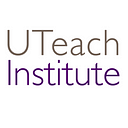K–12 Resources: Using AI to Enhance Personalization in Blended Learning Classrooms
by Kelli Allen, Professional Development Coordinator, UTeach Professional Development and Associate Professor of Practice, University of Texas at Austin

Challenges like staff shortages, paperwork, larger class sizes, behavior management issues, and an abundance of technology tools leave educators little time to create personalized learning experiences. A combination of a blended learning approach and artificial intelligence (AI) resources can allow teachers to make the best use of technology to meet the unique needs of each student.
Blended learning, which combines traditional in-person instruction with online learning, has become popular as a way to provide personalized experiences, encourage student agency, allow rigorous experiences, and build positive and collaborative relationships with the teacher and with other students. It also allows teachers to employ a systematic approach to assessment and data-informed teaching.
Blended learning approaches can be even more powerful with AI as a thought partner for the teacher.
Personalized Learning
Personalized learning provides customized learning experiences for each student according to their own abilities, learning preferences, individual backgrounds, and individual experiences. In a blended learning classroom, students are offered various learning opportunities, both online and offline, to master standards according to differentiated learning objectives. Teachers facilitate learning activities and provide personalized feedback to encourage continual progress. By adjusting learning goals to meet each student’s unique needs, educators can ensure that students are appropriately challenged and supported in their learning journey.
AI resource examples:
- Adaptive learning platforms like IXL and Dreambox can modify learning content and activities based on students’ mastery levels and learning preferences.
- Tools like ChatGPT can help educators create differentiated learning objectives for students based on mastery levels.
- Applications like Nearpod and Classkick can track students’ progress in real time, allowing teacher to identify areas where students may need additional support or enrichment.
Student Agency
Blended learning classrooms have student agency as a crucial component to give students control, autonomy, and power in their educational setting.
AI resources:
- MagicSchool.ai Choice Board tool helps provide appropriate prompts to incorporate student choice and voice in their learning.
- Edmodo is a social learning platform that offers AI-driven features to support personalized learning, goal setting, and tracking.
Rigorous Learning Experience
Blended learning classrooms provide a rigorous learning experience for students, where they engage in lesson activities, think critically, and work hard to achieve mastery of grade-level, college-ready, or student-appropriate content. AI should intentionally support personalized learning experiences in designing learning activities rather than being used solely as a time-saver for generating quick lesson plans.
AI resources:
- MagicSchool’s Make It Relevant! and Real World Connection tools aid teachers in ensuring the content’s relevance by improving outward communication. This way, there should be no question of “Why do I have to learn this?” with the response being “It’s on the test.”
- Diffit provides options to support critical thinking and problem-solving skills by requiring deep analysis.
Relationship Building
In blended learning classrooms, students develop positive, collaborative relationships with their teachers, other adults/mentors, and peers. These relationships are focused on high expectations for academic and personal growth. Through the relationship-building process, teachers better understand their students than AI tools could provide alone.
AI resource:
· MagicSchool’s Group Work Generator can facilitate student collaborative projects, encouraging teamwork, problem-solving, and creativity.
Assessment and Data-Driven Instruction
Blended learning classrooms employ a systematic approach to assessment and data-informed teaching. This approach helps teachers design and deliver instruction based on the specific learning needs of their students, monitor their learning progress, and provide them with feedback. AI tools can generate questions of varying difficulty, including specific vocabulary related to the learning objectives.
AI resource:
- Curipod can be used as a design partner to create pre-assessments to guide learning experiences based on prior knowledge, language proficiencies, and readiness. The results of the pre-assessments help teachers personalize learning activities for diverse groups of students.
Blended learning is a powerful approach to personalized instruction that leverages the power of technology and human relationships, and AI tools can support educators in developing and implementing
But it is essential to remember that AI tools cannot replace the human element of teaching. Instead, AI tools should serve as thought partners to help teachers create innovative lessons that challenge students in new and thoughtful ways. The combination of human expertise and AI offers a personalized and rigorous learning experience for all students.
More Resources
Visit the UTeach Professional Development website information about their course, Artificial Intelligence (AI) in Blended Learning Classrooms, and additional resources.
